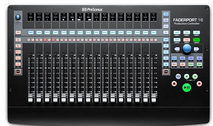Unleash your creativity with Studio One, a cutting-edge digital audio workstation designed for crafting, recording, mixing, and mastering your musical masterpieces. This powerful application also offers features for video production, making it a comprehensive tool for multimedia projects. Originally envisioned as a successor to the KRISTAL Audio Engine, Studio One was brought to life by PreSonus and made its debut in 2009, compatible with both macOS and Windows systems. In a significant move, PreSonus and Studio One became part of the Fender family in 2021, further enhancing their capabilities. Explore a variety of options with Studio One, including the commercial versions Studio One Artist and Studio One Professional, or try out the free Studio One Prime edition, which offers a taste of its features with some limitations. For those who want the full experience, the Professional version is available through the convenient Studio One+ subscription service.
Hardware control

The new Eris Studio series from PreSonus includes three models with different sizes, featuring four‑, five‑, and eight‑inch woofers. Here, we’re focusing on the largest model.
The DAW monitor’s physical format follows the common design found in smaller studios and home setups: a two‑way active system housed in a ported cabinet. To control the dispersion of the tweeter at the crossover point and maximize the width of the sweet spot, the tweeter is mounted in an EBM (Elliptical Boundary Modelled) waveguide, offering a 120 x 60‑degree (horizontal x vertical) dispersion. Previous two‑way models in the Eris range were well-received, but this new Studio version has undergone significant updates, featuring a woven‑composite cone woofer and a 1.25‑inch soft‑domed silk tweeter. The goal was to achieve a richer, more controlled low end and detailed highs, which PreSonus has successfully achieved. The woven‑composite cone construction provides both lightweight and mechanical stiffness.
These DAW monitors are bi‑amped, with a crossover at 3.5kHz and a total amplifier power of 140 Watts (75W for the lows, 65W for the highs). They cover the frequency range from 35Hz to 20kHz, with a quoted maximum SPL of 106dB peak at one meter.
The cabinets are internally braced and constructed from MDF with a black vinyl veneer. The front‑exiting reflex port is positioned near the bottom of the baffle. Slightly rounded cabinet edges, speaker aperture, and port exit help to reduce cabinet‑edge diffraction. All controls and connectors are located on the metal rear panel, mirroring the layout of the more expensive Eris Pro 8s. An LED bar on the front shows white in standby mode and turns blue when active.
Input options include unbalanced RCA phono, TRS balanced quarter‑inch jack, or balanced XLR, along with an overall input volume control. Acoustic tuning controls adjust for placement relative to boundaries: an Acoustic Space switch provides full‑, half‑, and quarter‑space placement (LF trim of 0, ‑2, and ‑4 dB respectively), plus separate HF and mid controls variable over ±6dB. There is also a high‑pass filter with options for off, 80Hz, or 100Hz. Built-in protection filters out RF, provides output‑current limiting, and over‑temperature protection. Additionally, there’s a soft‑start circuit to prevent power‑on or ‑off thumps and a subsonic filter to eliminate harmful ultra‑low frequencies.
In Use
Tests were conducted in my studio, away from walls and corners, alongside my reliable Event Opals. Despite the Eris Studio 8s costing around the same as the tax on the Opals, they performed admirably. By slightly adjusting the midrange control, I achieved a good timbral match between the two, though the Opals still excelled in bass depth and overall midrange focus. Nonetheless, the Eris Studio 8s offered punchy bass and tight sound for monitors in their price range, with clear and detailed highs from the silk‑domed tweeter. The wide sweet spot, strong stereo imaging, and good sound stage depth were notable. Once I adjusted the slightly forward mids using the rear‑panel EQ, the results were highly promising.
Given the affordability of the Eris Studio 8s, I am impressed. While all monitors involve compromises due to cost, physics, and design, the Eris Studio 8s offer a commendable price:performance ratio. They are an excellent choice for home studios, making them a top contender if you’re in the market for eight‑inch monitors in this price range.
Summary
The Eris Studio 8s deliver a reliable standard of monitoring for home studio owners working with restricted budgets.
£498 per pair including VAT.


0 Comments